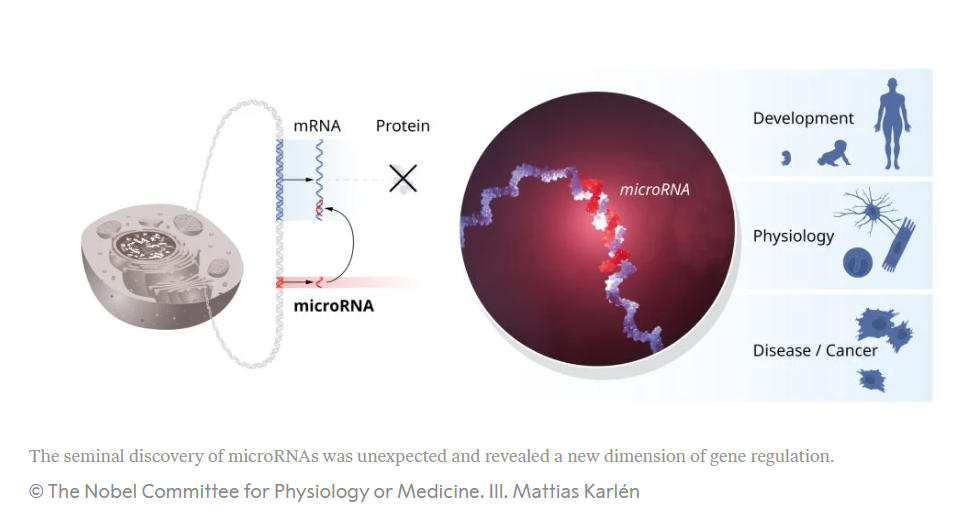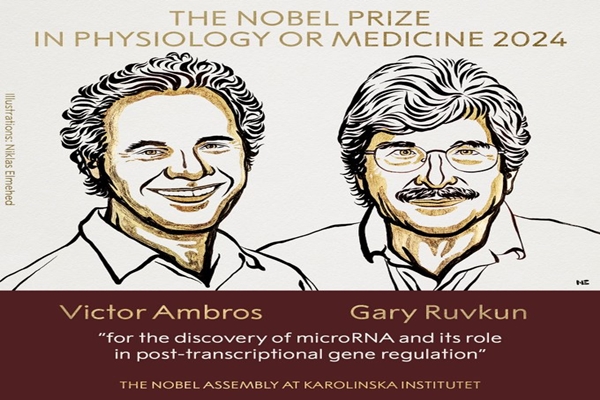The groundbreaking discovery of microRNAs by Victor Ambrose and Gary Ruvkun was deemed a landmark achievement for the 2024 Nobel Prize in Physiology or Medicine. This discovery has deepened our understanding of gene regulation in cells and shed a light on how genes orchestrate vital biological processes.
What Are microRNAs?

Our genome is akin to an instruction manual for the cells. Every cell of an organism contains the same chromosomes, hence carries the same genome and the very same instruction manual. However, we see different types of cells in a single organism despite the identical genome, such as cardiac cells, muscle cells, nerve cells, skin cells, etc. These cells have distinct characteristics unique to them. The question is: how do these differences arise in the first place with such precision? The answer is a mechanism called gene regulation, which ensures that the correct set of genes is active in a particular cell type. This is where microRNAs come in.
MicroRNAs or miRNAs are small, non-coding RNA molecules, about 21-15 nucleotides in length. During transcription, the messenger RNA (mRNA) carries genetic information for translation or protein production. MicroRNAs play a significant role in gene expression by binding to specific mRNAs to silence them by two methods: promoting degradation of mRNAs or preventing their translation into proteins. In this way, the microRNAs categorise the information carrying mRNAs as useful or unnecessary depending on the requirement of a cell, resulting in distinct characteristics of different cells.
Think of this whole process as a coffee shop serving different types of coffee, similar to the diversity of cells. The three ingredients of a coffee – coffee, milk, water – are like the genome. The microRNAs, in this analogy, is the barista. With the same ingredients, a barista can make different types of coffee by altering the proportions or omitting certain ingredients. For instance, an americano requires coffee and water while a flat white needs coffee and steamed milk. The varying ratios of steamed milk, milk foam and coffee produce either a latte or a cappuccino.
Discovery of microRNAs
The discovery of microRNAs began in the early 1990s with Victor Ambrose’s work using Caenorhabditis elegans as a model organism. Ambrose’s team identified a small RNA molecule called lin-4 that regulated the larval development by binding to the lin-14 gene. Gary Ruvkun’s team elucidated the role of lin-4 further. They revealed that lin-4 when bound to lin-14 mRNA prevented the production of LIN-14 protein in C. elegans. This study highlighted the transcriptional gene regulation mechanism and the potential of small RNAs acting as regulatory agents. Over the years, Ambrose, Ruvkun along with other scientists have demonstrated the existence of microRNAs across many species and their vital importance in development, metabolism, and diseases.
Impact on Medicine and Biology
Gene regulation through microRNAs has been crucial for the evolution of complex organisms, making its working mechanism more than millions of years old. The fine-tuning of cells, organs to organ systems and finally an organism is the meticulous handy work of microRNAs. Research indicates that the normal development of cells and tissues require microRNAs, while their functional abnormalities contribute to cancer, hearing loss, cardiovascular diseases, eye and skeletal disorders. Identification of thousands of microRNAs in humans has opened a new frontier in the therapeutic approaches. Pinpointing the exact microRNAs associated with specific diseases will facilitate the development of drugs targeting those microRNAs. Modulating the activity of microRNAs could potentially treat several conditions, including neurodevelopmental and genetic disorders. As the role of microRNAs is established in several diseases, new diagnostic and treatment methods will be developed to address major human diseases.
The discovery of microRNAs by Victor Ambrose and Gary Ruvkun is one of the most significant advancements in biological sciences. Their work elucidates a gene regulation mechanism that has operated for millions of years and continues even today. This intricate mechanism in the cells, at the microscopic scale, makes us appreciate its carefully crafted dynamics and vast implications on our development, evolution, and well-being. It has further laid the groundwork for novel therapeutic approaches that could unlock cures for complex diseases.

Deeksha, is a Biochemist and an aspiring neuroscientist. Her research interest lies at the intersection of molecular neuroscience and drug discovery.


